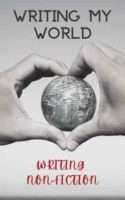What is information? Generally, information is considered to be factual, something that can generally be proved. And we are bombarded by information every day.
But what do we do with this information? Information becomes knowledge when it is considered necessary to know and meaningful to engage with. There are different ways to convey information so that it can be processed and become knowledge in the recipient’s consciousness.
There are many different genres of informational texts ranging from textbooks to academic papers to newspaper articles. The style of these genres will depend on the target audience and the kind of information being conveyed.
The important thing then for any informational text is to be absolutely clear who it is being written for, and why. If it is an audience that is already interested in the topic, then the writing can be in a very different style from an informational text that also has the aim of interesting people in the topic as well as telling them more about it.
Some information is written in a no-nonsense, factual way, gets straight to the point of what is necessary to do, and essential to know, to achieve a specific outcome.
Science writing falls into this category, that is, verifiable information that can be tested and which produces certain, predictable outcomes. This is especially so when scientists write for their peers, that is, other scientists.
However, sometimes you need to work harder to entice your audience! Some scientists themselves, for example, have become interested in sharing their cold hard facts with the warm mass of people who inhabit the earth, that is, those who are not scientists by profession, but who are still interested in what makes our world tick.
This kind of writing for a popular audience thus seeks to convey the essential bit of necessary information that the reader can use to better understand and act in her world, but couches it in language that is more accessible to a broader audience.
We can learn from good teachers here. Teachers the world over have the challenge of how to impart information in a way that is relevant and interesting to the learners they teach. Teachers who have this gift are far more effective than those who just give lists of facts and information without any consideration of their learners’ own lives, knowledges, and interests.
People need to understand why a particular piece of information is relevant or enriching to their lives, or perhaps their curiosity needs to be piqued. A good informational text writer needs to find the best way to hook their readers in to continue to read the content they want to convey.
While engaging your reader so that they begin reading is important, equally important of course is the accuracy of your information. Instructional texts – such as manuals, how-to guides, or recipe books – are a specific kind of informational writing, that needs to be particularly clear about the order in which readers have to carry out steps, as well as what tools or ingredients are needed, and in what quantities. They also need to know what their audience will understand, and what needs to be explained in more detail.
So to write an informational text you need to:
Know your content! It has to be well researched and accurate, and double-checked. And it does need to matter to you – you need to know why you think it is interesting, and worth sharing.
Know your audience. What are their interests? Why would they be interested in your topic? How can you hook them in – with a question? A reference to something else that links to your topic? A personal anecdote? People often enjoy reading about experiences they can relate to, and then you can move on to the ‘facts’ from there.
Make your information easy to consume. Often things like clear headings, short paragraphs – bullet points if necessary – can help readers to follow the structure of what you are describing. Avoid jargon or specialised terms unless you define what you mean in a clear and accessible way.
However there are no hard and fast rules. This informational text about Pompeii starts off with a situation that learners can relate to, and then uses story to to try to keep readers interested.
However, our many Did you know and How to blogs follow a different format, as they divide up the information into bite-size chunks. Here is a link to one of the highest-read Did you know blogs of the last year and here is one of the highest read ‘How to’ blogs.


